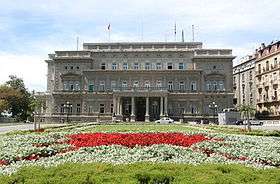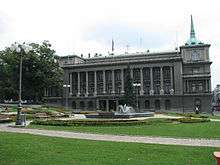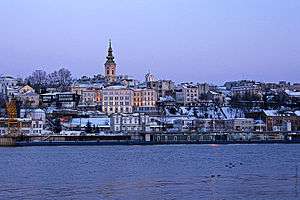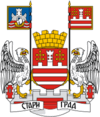Stari Grad, Belgrade
| Stari Grad Стари Град | ||
|---|---|---|
| Municipality | ||
| ||
 Belgrade's location within Serbia | ||
 Location of Stari Grad within Belgrade | ||
| Country | Serbia | |
| District | City of Belgrade | |
| Status | Municipality | |
| Settlements | 1 | |
| Government | ||
| • Municipality president | Marko Bastać (DS) | |
| Area | ||
| • Total | 7.0 km2 (2.7 sq mi) | |
| Population (2011) | ||
| • Total | 48,061 | |
| • Density | 6,900/km2 (18,000/sq mi) | |
| Time zone | CET (UTC+1) | |
| • Summer (DST) | CEST (UTC+2) | |
| Postal code | 11000 | |
| Area code(s) | +381 11 | |
| license plates | BG | |
| Website | www.starigrad.org.rs | |
Stari Grad (Serbian Cyrillic: Стари Град, pronounced [stâːriː ɡrâd]) is an urban neighborhood and one of 17 municipalities which constitute Belgrade, the capital of Serbia. It encompasses some of the oldest sections of urban Belgrade, thus the name (‘’stari grad’’, Serbian for “old city”). Stari Grad is one of the three municipalities that occupy the centre of the city (together with Savski Venac and Vračar).
Neighborhood
The neighborhood of Stari Grad is not generally considered by the Belgraders as one single definitive neighborhood. Area which Stari Grad covers is either simply styled "downtown" or by the names of the more established neighborhood which it overlaps: Two parts of Dorćol separated on social-difference and architecture basis, It spreads from the bank of Danube by the Kalemegdan fortress to the Republic Square also known as "The Horse". Downtown Belgrade is most populated area which makes it the heart of the city, it spreads from Terazije down to Despot Stefan Boulevard. Tasmajdan neighborhood is along with Šipka the on the east side of Stari grad next to municipality of Palilula.
Municipality
Geography
Stari Grad occupies the ending ridge of Šumadija geological bar. The cliff-like ridge, where the fortress of Kalemegdan is located, overlooks the Great War Island and the confluence of the Sava river into the Danube, and makes one of the most beautiful natural lookouts in Belgrade. With Novi Beograd, it is one of 2 municipalities of Belgrade (out of 17) which occupy the banks of both major rivers in Belgrade, the Sava and the Danube (Zemun was the third, but when the municipality of Surčin split, Zemun was left with the Danube, and Surčin with the Sava bank).
The municipality of Stari Grad covers an area of just 7 square kilometers (2.7 sq mi) (second smallest in Belgrade, after Vračar) and borders the municipalities of Paliula on the east, Vračar on the south-east and Savski Venac on the south. The Sava makes a border to the municipality of Novi Beograd (west) and the Danube to the municipalities of Zemun (north-west) and the Banat's section of Palilula.
The riverside of the Danube has two distinct artificial bays, the small marina (Marina Dorćol) and the Port of Belgrade.
Population
Like the other two "old" municipalities of central Belgrade (Savski Venac and Vračar), Stari Grad for decades is a highly depopulating municipality, but being a central municipality and small in area, it remains one of the most densely populated municipalities in Serbia. There were 48,061 inhabitants according to the 2011 census or 6,866/km2 (17,780/sq mi), compared to a population of 96,517 with a density of 13,788/km2 (35,710/sq mi) back in 1971. Population of Stari Grad:
- 1961 - 96,517
- 1971 - 83,742
- 1981 - 73,767
- 1991 - 68,552
- 2002 - 55,543
- 2011 - 48,061 (49.8% of the 1961 population)
Even though residential areas are much densely compact compared to Vračar, the latter is densely populated because almost one third of Stari Grad, even though it is "heart" of Belgrade is not inhabited (mostly the large park of Kalemegdan and the highly industrialized riverside of the Danube, with dozens of factories and spacious hangars and depots). However, a number of people working on the territory of the municipality doubles its own population and makes possible for the municipality of Stari Grad to achieve GDP per capita 6 to 8 times higher than the average in Serbia.
History and administration
Despite some of the oldest sections of Belgrade belong to Stari Grad, the municipality itself is among the latest urban ones formed administratively. It was formed by the merger of the municipality of Skadarlija and part of the municipality of Terazije on January 1, 1957.
Recent Presidents of the Municipality:
- 1992–2000: Jovan Kažić (b. 1937)
- 2000–June 21, 2012: Mirjana Božidarević (b. 1954)
- June 21, 2012–May 12, 2016: Dejan Kovačević (b. 1966)
- May 12, 2016–present: Marko Bastać (b. 1984)
International relations
Twin towns — Sister cities
Stari Grad is twinned with:
-
 Yermasoyia, Cyprus
Yermasoyia, Cyprus -
 Kotor, Montenegro
Kotor, Montenegro -
 Staré Mesto, Bratislava, Slovakia
Staré Mesto, Bratislava, Slovakia -
 Centar, Skopje, Republic of Macedonia
Centar, Skopje, Republic of Macedonia -
 Erzsébetváros, Budapest, Hungary
Erzsébetváros, Budapest, Hungary -
.svg.png) Belgrade, Namur, Belgium
Belgrade, Namur, Belgium
Neighborhoods
|
Features


Administration
Economy and tourism
- Large industrial zone on the riverside of the Danube (including the Port of Belgrade)
- BEKO clothing factory
- Belgrade Fortress with the Kalemegdan park
- Botanical garden of Jevremovac
- Belgrade Zoo
- Prince Michael Street
- Bohemian quarter of Skadarlija
- Aleksandar Palas[1] *****
- Hotel Majestic ****
- Hotel Palace ****
- Le Petit Piaf[2] ***
- Hotel Royal ***
Culture

- Serbian Academy of Sciences and Arts
- Museum of Applied Arts (Vuka Karadžica 18)
- National Museum of Serbia (Trg republike 1a)
- Konak Kneginje Ljubice (Kneza Sime Markovića 3)
- Serbian Orthodox Church Museum[3] (Kralja Petra I 5)
- Military Museum (Kalemegdan)
- Museum of Belgrade Fortress (Kalemegdan)
- Museum of Ethnography (Studentski trg 13)
- Museum of Pedagogy[4] (Uzun Mirkova 14)
- Museum of the City of Belgrade (Zmaj Jovina 1)
- Museum of Theatrical Arts of Serbia (Gospodar Jevremova 19)
- Jewish Historical Museum[5] (Kralja Petra I 71/1)
- Museum of Vuk and Dositej (Gospodar Jevremova 21)
- Museum of Automobiles[6] (Majke Jevrosime 30)
As a curiosity, Stari Grad is location of two shortest streets of Belgrade, Marka Leka and Laze Pačua, which are 45 and 48 meters long, respectively.[7] Despite being in the sole downtown and densely populated urban section, they have no numbers as all the buildings located in them are numbered from the neighboring streets.
See also
References
External links
Coordinates: 44°49′09″N 20°27′26″E / 44.8191359°N 20.4572362°E
| Wikimedia Commons has media related to Stari Grad, Belgrade. |




